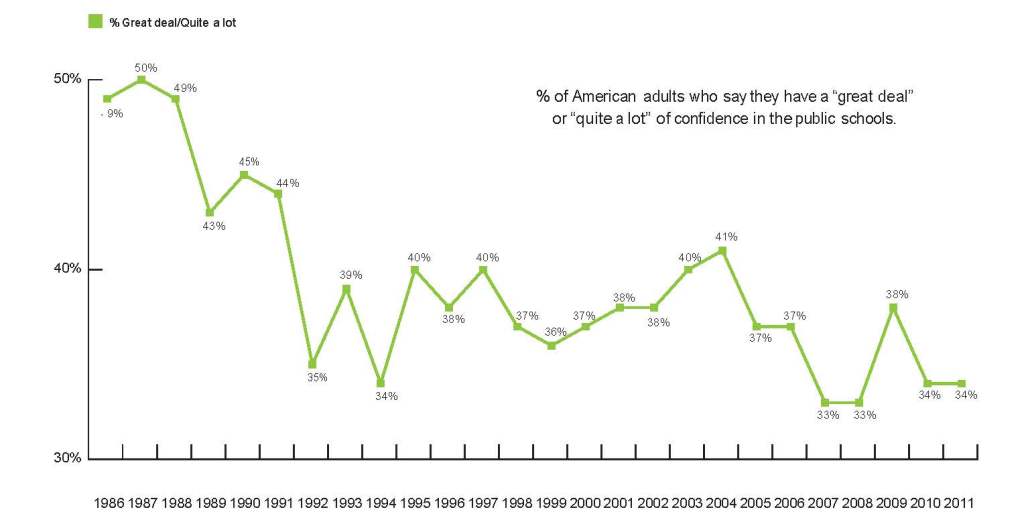
As formal learning methods are cast in doubt, the learning landscape is reinvented.
We see signs that the U.S. is nearing the end of an era in formal learning characterized by teachers, physical classrooms, age-cohorts and a core curriculum—what some people call the industrialized era of learning. The signs heralding this transformation include the rapid increase in non-traditional forms of primary education such as homeschooling; near record dissatisfaction with the existing K-12 education system; funding crises for schools at the state and local levels; a growing gender
imbalance in higher education; and the proliferation of digital content and digital delivery platforms designed to transform the nature of classroom learning.
While a four-year college degree used to be the ticket to success, now it takes an advanced degree (and often massive educational debt) to capture that advantage. The prospects for those without a college degree are worse, and falling. At the same time, some of the most prominent new tech billionaires bypassed the traditional degree system and leapt directly into the workplace. In the new educational era, learning may become disassociated from age-cohorts; be individualized and self-directed;
supported by educators who are primarily aggregators, facilitators and mentors rather than lecturers; draw on distributed sources of content (many of them virtual); and take place in a variety of physical settings. Educational attainment may be documented by a portfolio of digital badges and real-world projects, rather than traditional grades or certificates.
Examples:
- In Houston, a private Montessori high school is turning the whole museum district into a classroom.
- The nonprofit Khan Academy offers more than 2,400 online instructional videos and 150 practice exercises. Backed by megafunders such as Bill Gates and Google, the academy is beginning to mainstream into schools, integrating its material into a handson, blended-learning experience. The academy recently merged with Smarthistory to incorporate art history into its content.
-
MakeShop at the Children’s Museum of Pittsburgh pushes the envelope of informal learning via the integration of old and new technologies into DIY, project-based activities in a hands-on workshop environment that connects kids to indie crafters, hackers and inventors. Created in partnership with Carnegie Mellon University’s Entertainment Technology Center (ETC) and the University of Pittsburgh Center for Learning in Out-of-School Environments (UPCLOSE), MakeShop is linked to
“maker spaces” across the country that are exploring and evaluating the impact of making on learning for early and middle childhood. - ArtLab+ at the Hirshhorn Museum and Sculpture Gallery in Washington, D.C., is a digital media studio that gives local teens the opportunity to become integral members of a design team. Team-based learning is increasingly valued in the workplace, but poorly taught and assessed in the schools.

What does this mean for society?
Educators, employers and government need to rethink and rebuild the educational infrastructure, and parents, community groups and a wide range of civic organizations, including museums, need to be involved. By acting now we may avoid creating a “lost generation” of students who fall between the cracks as affluent/savvy/engaged parents jump on new educational formats and old, underfunded, underperforming systems crumble.
What does this mean for museums?
The contributions that museums already make to public education are usually seen as peripheral—nice, not necessary. Policymakers, reformers and practitioners need to understand the crucial role that museums can play in the new educational infrastructure. The U.S. needs to scale up the educational resources and skills provided by its
museums via online access, better indexing of online resources, physically incorporating museums into schools and schools into museums, and making museums central points for teacher training. This will ensure that museums provide equitable access to their unique resources and fulfill their potential in the new educational landscape.
Even as they help pioneer the new era, museums need to stay engaged with the current educational system, both to serve today’s students and to ensure their own financial health. Museums will be offering field trips for a long time to come.
Declining Confidence in America’s Public Schools, 1986–2011

Museums might want to consider:
- Contribute to the “cycles of prototyping and experimentation” necessary for the educational system to evolve into its new form.
- Partner with community organizations and groups to explore new ways of approaching learning.
- Focus on the broader educational needs and interests of communities; if necessary, change offerings and the way they are presented to stakeholders.
- Use technology to help students, teachers and the community access museum learning resources.
- Improve the assessment of informal learning, while asserting that some of the most valuable benefits of informal learning are not easily measured.
- Make decisions about physical infrastructure (where to place new buildings, what facilities to provide) that ensure museums are easily accessible to learners—next to schools, in schools, encompassing schools, supplementing schools.
Further reading:
For an edgy glimpse of potential educational futures, see the KnowledgeWorks Foundation’s 2020 Forecast: Creating the Future of Learning.
To keep up with the latest








